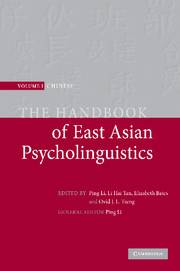Book contents
- Frontmatter
- Contents
- List of figures
- Notes on contributors
- Preface
- Introduction: new frontiers in Chinese psycholinguistics
- Part I Language acquisition
- 1 Actions and results in the acquisition of Cantonese verbs
- 2 Chinese children's knowledge of the Binding Principles
- 3 Chinese classifiers: their use and acquisition
- 4 Child language acquisition of temporality in Mandarin Chinese
- 5 Second language acquisition by native Chinese speakers
- 6 Making explicit children's implicit epilanguage in learning to read Chinese
- 7 Emergent literacy skills in Chinese
- 8 Basic syntactic categories in early language development
- 9 Growth of orthography-phonology knowledge in the Chinese writing system
- 10 Interaction of biological and environmental factors in phonological learning
- 11 The importance of verbs in Chinese
- 12 Grammar acquisition via parameter setting
- 13 Early bilingual acquisition in the Chinese context
- Part II Language processing
- Part III Language and the brain
- Epilogue: a tribute to Elizabeth Bates
- References
- Name index
- Subject index
10 - Interaction of biological and environmental factors in phonological learning
Published online by Cambridge University Press: 05 June 2012
- Frontmatter
- Contents
- List of figures
- Notes on contributors
- Preface
- Introduction: new frontiers in Chinese psycholinguistics
- Part I Language acquisition
- 1 Actions and results in the acquisition of Cantonese verbs
- 2 Chinese children's knowledge of the Binding Principles
- 3 Chinese classifiers: their use and acquisition
- 4 Child language acquisition of temporality in Mandarin Chinese
- 5 Second language acquisition by native Chinese speakers
- 6 Making explicit children's implicit epilanguage in learning to read Chinese
- 7 Emergent literacy skills in Chinese
- 8 Basic syntactic categories in early language development
- 9 Growth of orthography-phonology knowledge in the Chinese writing system
- 10 Interaction of biological and environmental factors in phonological learning
- 11 The importance of verbs in Chinese
- 12 Grammar acquisition via parameter setting
- 13 Early bilingual acquisition in the Chinese context
- Part II Language processing
- Part III Language and the brain
- Epilogue: a tribute to Elizabeth Bates
- References
- Name index
- Subject index
Summary
Introduction
Despite decades of research on speech development in children, three fundamental questions remain unanswered:
Just how universal are patterns of phonological development?
How do basic biological and environmental factors interact to impinge on phonological learning?
What mechanisms account for high individual variability in the rate and route of phonological learning?
These questions have been raised repeatedly in recent years (e.g. Ingram, 1999; Macken, 1995; Stoel-Gammon, 1992) yet they remain largely unanswered. Recent work has provided new and intriguing possible answers to these questions. First, there is now widespread evidence that patterns of phonological development are universal, insofar as all development follows an implicational hierarchy of increasing feature complexity (Jakobson, 1968; Dinnsen et al., 1990; Macken, 1995; Stokes et al., in press). Second, recent studies of Chinese phonological development clearly indicate a computational interaction of ambient language (input) and articulatory (motor) constraints on consonant and vowel learning (Stokes & To, 2002; Stokes & I.-M. Wong, 2002; Stokes, Lau & Ciocca, 2002; Stokes & C. T.-Y. Wong, 2004; Stokes & Surendran, 2005). Third, Plaut and Kello (1999) provide a convincing demonstration of phonological learning by a connectionist model that reflects possible cognitive processes of phonological learning in the child. This chapter describes how recent research addresses learnability issues in phonological development, with a focus on Chinese.
Before describing this research, a digression is required to briefly outline the phonological systems of Cantonese and Putonghua.
- Type
- Chapter
- Information
- The Handbook of East Asian Psycholinguistics , pp. 114 - 123Publisher: Cambridge University PressPrint publication year: 2006
- 2
- Cited by

